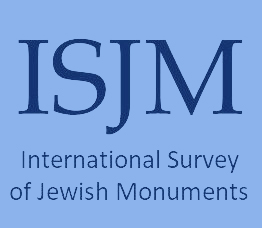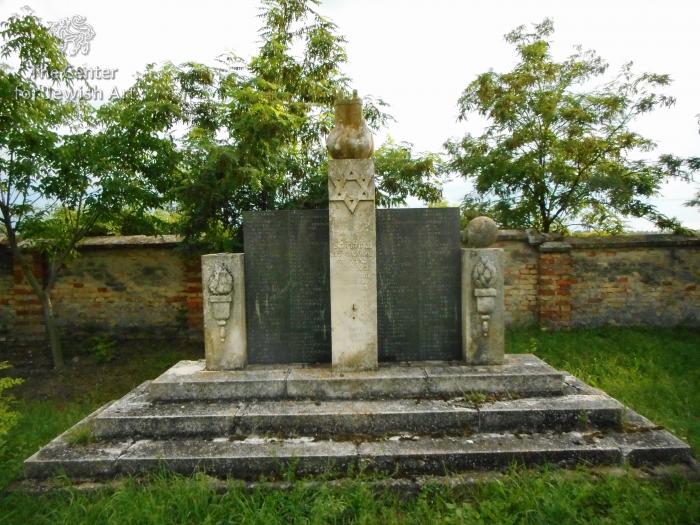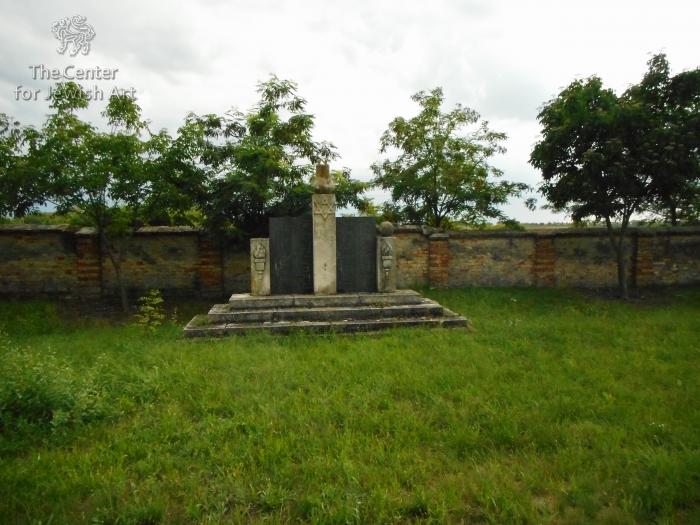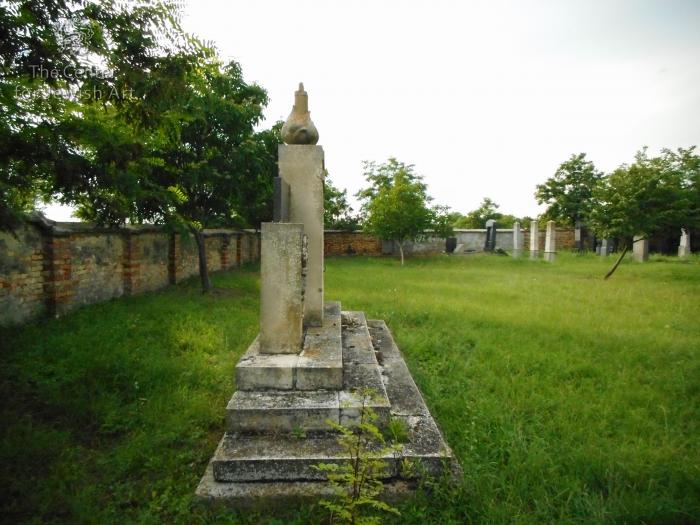Obj. ID: 44759 Holocaust memorial in the Jewish Cemetery in Kanjiža, Serbia, 1948

Memorial Name
No official name
Who is Comemmorated?
Victims of the Holocaust from Kanjiža
Description
The monument is a wall-like structure made of black marble and sandstone. The structure is divided into two sections by three columns (with the central column being higher than the others) of sandstone that feature traditional Jewish motifs: the central one bears a Magen David and Torah Scroll, and the two side columns bear the Ner Tamid. On the central column are commemorative inscriptions in Hebrew and Serbo-Croatian, and an inscription in Hungarian about the memorial's renovation in 1971 at its bottom. On both sides of the central column are two panels made of black marble, on which are inscribed the names of victims in Latin script phonetically spelled according to Serbian orthography.
Inscriptions
Central Column
Hebrew
שנזכור הקדושים שנהרגו מקהילתינו על קד' ה'ש בשנת תש'ד'
Translation: To remember the martyrs from our community who were killed for the sanctification of God's Name [Kiddush Hashem] in the year 5704 [1943-1944]
Serbo-Croatian
Sećanje na žrtve iz godina 1941-1945
Translation: Remembering the Victims of 1941-1945
Hungarian
Ujja epitette
a helyi
harcos szovetseg 1971
[Translator notes it should be: Újjáépitette a helyi harcos szövetség 1971]
Translation: It was rebuilt by the local Fighters’ Association in 1971
Commissioned by
The Jewish Community of Kanjiža
Granite
Jews began settling in Kanjiža in the second half of the 18th century. The cemetery was founded in 1802. The synagogue was built in 1861, on the corner of 1 Bolmanska Street and Dože Đerđa Streets. The Jewish school was built in 1867 and was located across the street from the synagogue. The same year, the Jewish kindergarten was established. It was located on the corner of Bolmanska and Drapšinova Streets. At the beginning of the 20th century, 375 Jews lived in this town. The number of Holocaust survivors is 63. The synagogue was demolished in 1948. The building of the kindergarten exists today.
The cemetery has around 230 gravestones. The most common shapes of the gravestones are stele and obelisk. The stelae are older types of tombs. The form of the obelisk became dominant in the 1870s. This change indicates signs of suppression of orthodoxy. A similar tendency is seen in the languages of the inscriptions: the ones in Hebrew are from earlier periods, while the appearance of bilingual Hungarian-Hebrew inscriptions coincides with the appearance of the obelisk-shaped gravestones. The cemetery is inactive. In 1983, the ownership over it was transferred to the municipality of Kanjiža.
The monument was unveiled on 10 October 1948. Between 1947 and 1948, there were several similar "ad hoc, uncoordinated initiatives that were driven largely by the sense of obligation of the surviving Jews towards their murdered relatives and friends." [Kerenji, p. 209] As a result of these initiatives small monuments and plaques were dedicated by communities in Vojvodina, among them Subotica, Sombor, Stara Kanjiža and Senta.
The monument went through renovation in 1971 initiated and organized by the local Association of Fighters of the People’s Liberation War. In May 2004, the monument was vandalized, when one of the panels carrying the names of victims was torn down. The panel was restored and today the monument and the whole graveyard are in relatively good condition thanks to the care and enthusiasm of Mr. Miklós Kordován from Kanjiža.
Kerenji, Emil, “Jewish Citizens of Socialist Yugoslavia: Politics of Jewish Identity in a Socialist State, 1944–1974,” Ph.D. diss., University of Michigan, 2008, p. 201., https://deepblue.lib.umich.edu/bitstream/handle/2027.42/60848/ekerenji_1.pdf?sequence=1. June 2020 (accessed February 23, 2022)
"Memorial in Kanjiža," Locations (Vojvodina Holocaust Memorials Project), https://www.vhmproject.org/en-US/Locations/Memorials/12 (accessed June 14, 2023)
Pejin, Attila. “Tisza menti zsidó temetõk – Magyarkanizsa,“ Hid 1 (2015):, pp. 111-121.
Ungar, Olga, "Remembering the Victims: Vojvodina Holocaust Memorials," in Jewish Literatures and Cultures in Southeastern Europe: Experiences, Positions, Memories (=Schriften des Centrums für jüdische Studien, vol. 37) eds Renate Hansen-Kokoruš and Olaf Terpitz, pp. 217-236.























